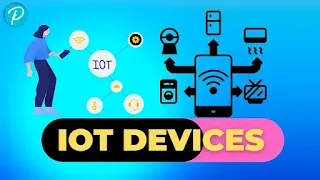What is IoT Devices:
The Internet of Things (IoT) is a network of physical devices, vehicles, buildings, and other objects embedded with sensors, software, and connectivity which enables these objects to collect and exchange data. The IoT is transforming the way we live, work, and play by connecting everyday devices to the internet and allowing them to communicate with one another, creating a more seamless and efficient experience for users.
Usages of IoT devices
One of the most significant uses of IoT is in the realm of smart homes. Smart home devices such as thermostats, lighting, and security systems can all be controlled and monitored remotely through a smartphone or tablet. This allows homeowners to not only control their home's environment but also keep an eye on their property while they are away.
Another major use of IoT is in the industrial sector. IoT-enabled devices and sensors can monitor and optimize equipment and machinery, reducing downtime and increasing efficiency. Additionally, IoT technology can be used to track and monitor inventory, allowing companies to better manage their supply chain and improve their bottom line.
The healthcare industry is also utilizing IoT technology to improve patient care and streamline operations. IoT-enabled devices such as wearables and telemedicine equipment allow healthcare professionals to monitor patients remotely, reducing the need for hospital visits and improving patient outcomes. Additionally, IoT technology can be used to track and monitor vital signs, allowing healthcare professionals to quickly identify and respond to potential health issues.
IoT devices typically work by collecting data from sensors, which is then sent to the cloud for processing and analysis. Once the data is processed, it is then sent back to the device or to a smartphone or tablet for the user to interact with. This process is facilitated by the use of wireless communication protocols such as Wi-Fi, Bluetooth, and cellular networks.
The IoT ecosystem also includes a number of platforms, such as Amazon Web Services (AWS), Microsoft Azure, and Google Cloud IoT, that allow developers to easily connect and manage IoT devices. These platforms provide a range of services, including device management, data storage and analysis, and machine learning capabilities, making it easier for developers to create new IoT applications and services.
Challenges with IoT devices
One of the key challenges facing the IoT is security. As more and more devices are connected to the internet, the risk of cyber attacks increases. To address this issue, IoT devices must be built with robust security features, such as encryption and secure communication protocols. Additionally, it is important for users to change the default passwords on their IoT devices and to keep their devices and software updated with the latest security patches.
Another challenge facing the IoT is the issue of data privacy. As IoT devices collect and transmit large amounts of personal data, it is important that this data is protected and used responsibly. To address this issue, companies must implement strict data privacy policies and comply with relevant regulations, such as the General Data Protection Regulation (GDPR) in the European Union.
Conclusion
In conclusion, the Internet of Things is a rapidly growing technology that is transforming the way we live, work, and play. From smart homes to industrial applications and healthcare, IoT technology is making our lives more efficient and convenient. However, as the number of connected devices increases, it is important that the security and privacy of personal data are given the highest priority to ensure a safe and secure IoT ecosystem.

